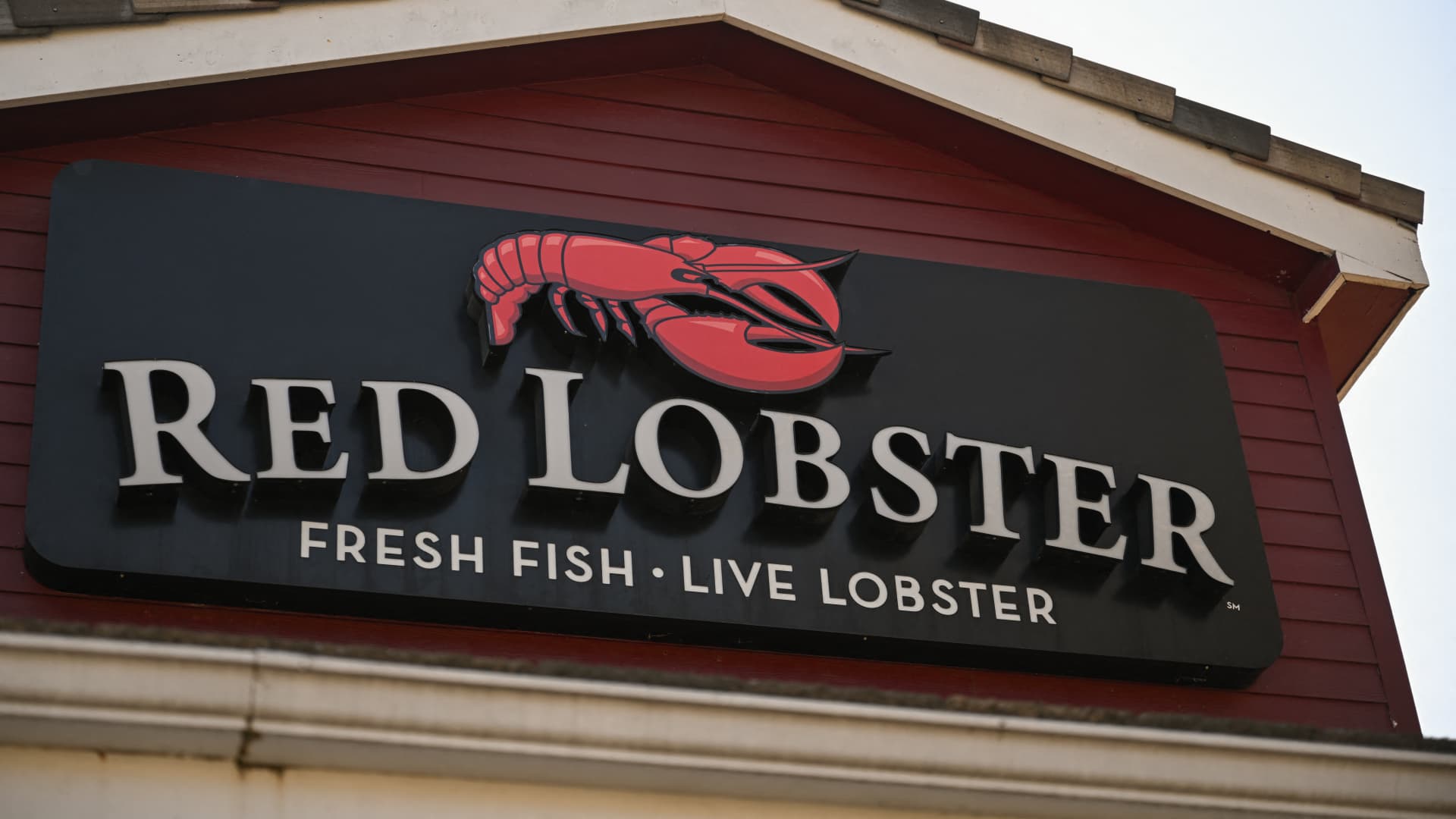The Red Lobster logo is displayed outside of a closed restaurant in Torrance, California, on May 14, 2024.
Patrick T. Fallon | Afp | Getty Images
Restaurant bankruptcy filings have surged so far this year, echoing a broader rise in corporate bankruptcies across sectors.
At least 10 restaurant chains, not including multi-unit franchisees, have filed for bankruptcy in 2024. August alone brought three Chapter 11 filings from notable eateries. The increase in bankruptcies comes as diners pull back their spending, labor costs keep rising and Covid-era government help disappears.
Several more restaurant chains could file for bankruptcy before the end of the year. BurgerFi, which also owns Anthony’s Coal Fired Pizza & Wings, said in a regulatory filing in mid-August that there is “substantial doubt” about the company’s ability to operate. Others, such as Mod Pizza, have narrowly avoided bankruptcy through a last-minute sale.
Restaurants are not the only companies seeking bankruptcy protection as high interest rates weigh on businesses. Chapter 11 filings have climbed 49% this year as of Aug. 20, according to BankruptcyWatch. Mall retailer Express, nursing home chain LaVie Care Centers and Joann Fabrics and Crafts are among the companies that have filed for bankruptcy protection this year.
Here are the 10 notable restaurant chains that filed for bankruptcy protection in 2024:
Roti
Mediterranean fast-casual chain Roti filed for Chapter 11 bankruptcy protection on Aug. 23. The company said it is working with its landlords and suppliers to keep its 22 locations open while it searches for a new buyer or investors.
The company began struggling during the Covid-19 pandemic because roughly half its locations were in downtown business districts, CEO Justin Seamonds said in a statement at the time of the bankruptcy filing. New investors helped it hold on, but the recent downturn in consumer spending led to insolvency.
Roti had raised $58 million as of June, according to Pitchbook.
Buca di Beppo
People dine outside a Buca di Beppo restaurant in San Diego on Aug. 11, 2020.
Bing Guan | Bloomberg | Getty Images
Buca di Beppo declared bankruptcy on Aug. 5. The Italian American chain is keeping 44 of its locations open while it restructures, and plans to open another restaurant, too.
The company blamed its financial difficulties on rising costs and labor challenges, according to court filings.
Buca di Beppo was founded in 1993 and sold to Planet Hollywood in 2008, following an accounting scandal involving some of its top executives.
World of Beer
The exterior of World of Beer at Crossgates Mall in Guilderland, New York.
Lori Van Buren/ | Albany Times Union | Hearst Newspapers | Getty Images
Tavern chain World of Beer filed for bankruptcy protection on Aug. 2. The company blamed high interest rates, inflation and a slow return to pre-pandemic dining habits.
World of Beer plans to restructure and end leases at underperforming locations through bankruptcy.
The company was founded in 2007, when craft beer popularity was soaring. These days, craft beer sales have fallen as consumers broadly drink less.
Rubio’s
Rubio’s Restaurants filed for Chapter 11 bankruptcy protection in June. The fast-casual chain, known for its fish tacos, had 86 locations at the time across California, Nevada and Arizona.
The company said rising food and utility costs, the shift to hybrid work cutting lunchtime traffic and minimum wage hikes in California put too much pressure on some of its restaurants.
In April, California raised its minimum wage for fast-food workers at chains with more than 60 locations to $20 an hour. Several days before it filed for bankruptcy, Rubio’s closed 48 underperforming restaurants in California.
In August, Rubio’s agreed to a sale to an affiliate of TREW Capital, one of its lenders.
The restaurant company previously filed for Chapter 11 bankruptcy in 2020.
Melt Bar & Grilled
In June, the Cleveland-based chain said it was struggling to pay its vendors and landlords. It turned to Chapter 11 to save the business.
The company, known for its grilled cheese sandwiches and craft beer offerings, was founded in 2006. It had 14 locations at its peak, but its footprint had dwindled to four restaurants by the time of its bankruptcy filing.
Kuma’s Corner
Kuma Holdings, the parent company of Kuma’s Corner, filed for bankruptcy protection in June.
The midwestern burger chain opened its first location in 2005, setting itself apart from the competition with its metal- and punk-themed menu items.
Red Lobster
A menu is displayed on a plate at a Red Lobster restaurant in Austin, Texas, on May 20, 2024.
Brandon Bell | Getty Images
Seafood giant Red Lobster filed for bankruptcy protection in May, citing a “difficult macroeconomic environment, a bloated and underperforming restaurant footprint, failed or ill-advised strategic initiatives, and increased competition.”
One scapegoat for its insolvency was its disastrous “endless shrimp” promotion in 2023. But a less-obvious culprit was a lease-back agreement made under a prior owner that made Red Lobster’s leases too expensive, especially as sales fell.
On Tuesday, the investment group buying Red Lobster tapped former P.F. Chang’s CEO Damola Adamolekun as the company’s next leader if it exits Chapter 11 successfully.
Tijuana Flats
A Mexican-style pizza from at Tijuana Flats.
Jeff Greenberg | Universal Images Group | Getty Images
In April, Tijuana Flats announced new ownership, a Chapter 11 bankruptcy filing and the closure of 11 restaurants in a single press release.
AUA Private Equity Partners sold the fast-casual Tex-Mex chain to Flatheads LLC as part of the restaurant company’s restructuring.
The chain was founded in 1995.
Sticky’s Finger Joint
Chicken-tender chain Sticky’s Finger Joint also declared bankruptcy in April. Rising commodity costs, the hangover from the pandemic and legal expenses from a trademark case brought by rival Sticky Fingers led the company to restructure.
Sticky’s was founded in 2012. By 2023, it had annual sales of $22 million, according to a court filing.
Boxer Ramen
The Portland, Oregon ramen chain filed for Chapter 11 bankruptcy protection in February. In late April, it abruptly closed all four of its locations, more than a decade after the chain’s founding.















